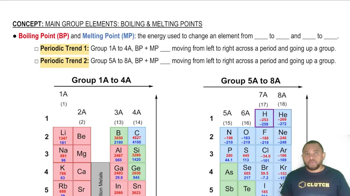Here are the essential concepts you must grasp in order to answer the question correctly.
Types of Solids
Solids can be classified into four main types: molecular, metallic, covalent-network, and ionic. Each type has distinct properties based on the nature of the bonding and structure. Molecular solids consist of molecules held together by intermolecular forces, metallic solids consist of metal atoms sharing electrons, covalent-network solids have atoms connected by covalent bonds in a continuous network, and ionic solids are composed of ions held together by electrostatic forces.
Recommended video:
Crystalline Solids Structure
Electrical Conductivity
Electrical conductivity refers to a material's ability to conduct electric current. In solids, this property is influenced by the presence of free-moving charged particles. Metallic solids are good conductors due to the mobility of delocalized electrons, while ionic solids conduct electricity when melted or dissolved in water, as ions can move freely. The gray substance in the question is a conductor, suggesting it may be metallic.
Recommended video:
Extensive Property Example
Melting Point and Solubility
The melting point of a substance provides insight into its bonding and structure. A high melting point, like 700 °C, typically indicates strong bonding forces, such as those found in metallic or covalent-network solids. Additionally, solubility in water can help differentiate between types; for instance, ionic solids are often soluble, while metallic and covalent-network solids are generally insoluble. The gray substance's high melting point and insolubility suggest it is likely a metallic solid.
Recommended video:
Boiling Point and Melting Point
 Verified step by step guidance
Verified step by step guidance


